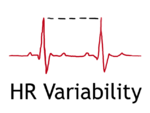HRV
Home Lab Members Physiological Systems Monitoring Parameters in the ICU ECG HRV Cardiorespiratory Monitors Clinician's Perspective Signal Processing Deliverables Journal Abbreviations
Overview
Cardiorespiratory monitoring is a very important area of modern medicine. For example, cardiorespiratory monitors are a key component in any intensive care unit. The reason for this is that respiration and the heart and circulation are key physiological systems. The aim of the project is to investigate these systems and how heart rate variability is both a function of their operation and a key indicator of physiological state.

The variation in R intervals is called Heart Rate Variability (HRV).
| Phase 1 | Phase 2 |
| Phase 1 of the project comprises a “library” investigation into the physiological systems of respiration, cardiovascular and blood pressure control, and thermoregulation.
Our team investigated the basis of these physiological systems with an aim to understand their importance. Having established their basic physiological behaviour, the next step was to identify the parameters that were paramount to clinicians when monitoring the critically ill in an ICU/ITU setting. One of the physiological signals that are monitored on a continuous basis is the ECG. We investigated the clinical significance of ECG in by identifying two important aspects of the ECG, in terms of medicine, the first is the morphology and the second is the variations in heart rate. Over the last 20 years, the beat by beat variation in heart rate (HRV) has become an increasingly important indicator of underlying physiological state. We studied the reason for this, particularly in relation to respiration, blood pressure, and temperature regulation. Our team performed a detailed analysis of how HRV is currently used in clinical medicine and established a link to cardiorespiratory monitoring. Finally, we explored the importance of cardiorespiratory monitoring in relation to defining patient state in the ICU/ITU. We looked into the whole area of cardiorespiratory monitors developed by various companies, their features and their function within an ITU. |
Phase 2 involves signal processing in order to take basic numerical ECG data and convert it to HRV which can then be used to analyse the health of a patient.
In order to create an algorithm which is able to accurately extract HRV and use it in a way which is useful to a clinician, the signal processing is broken down into the following steps: 1. Obtaining ECG data from archives 2. Using this data to plot a typical ECG waveform 3. Removal of noise 4. Detection of the R wave peak 5. Extrapolation of R wave peak to HRV in the time domain 6. Linking this is changes in physiological signal to predict medical events More steps may be added through the process depending on what is found at each stage. The team will be using Python to accomplish this, due to its functionality and similarity to programming languages the team is already proficient in. |


